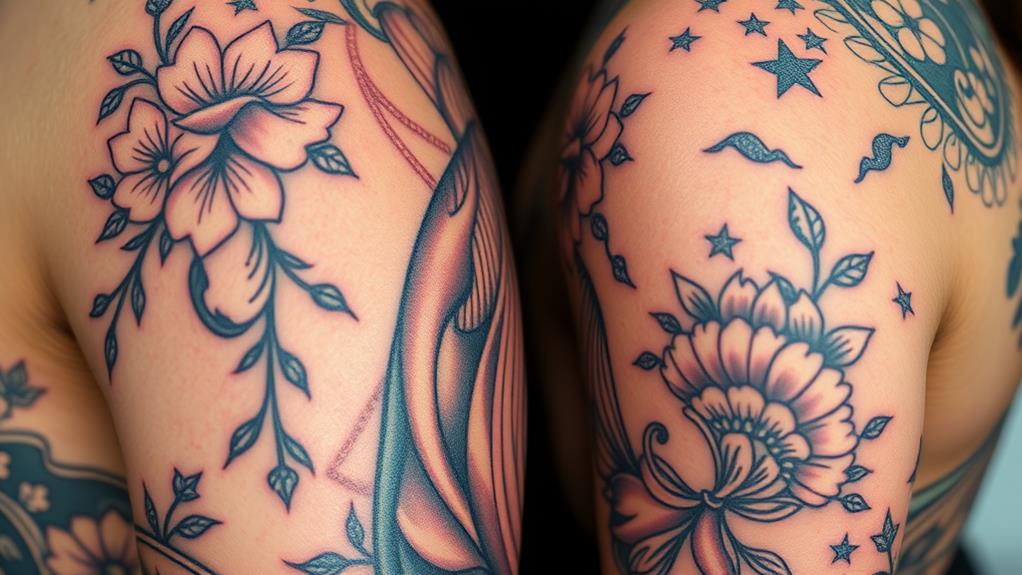Theotokos tattoos resonate deeply with the rich tapestry of Christian theology and maternal symbolism. I find that these designs often portray Mary with the Christ child, emphasizing themes of nurturing and divine protection. The historical significance of the Theotokos, honored since the Council of Ephesus, elevates her role in salvation. Choosing a placement for these tattoos can greatly affect their personal meaning, while modern interpretations allow for unique, expressive artistry. By selecting a skilled artist who appreciates the cultural context, I guarantee the tattoo reflects my faith. Exploring these elements reveals even more about their profound significance.
Historical Significance of Theotokos
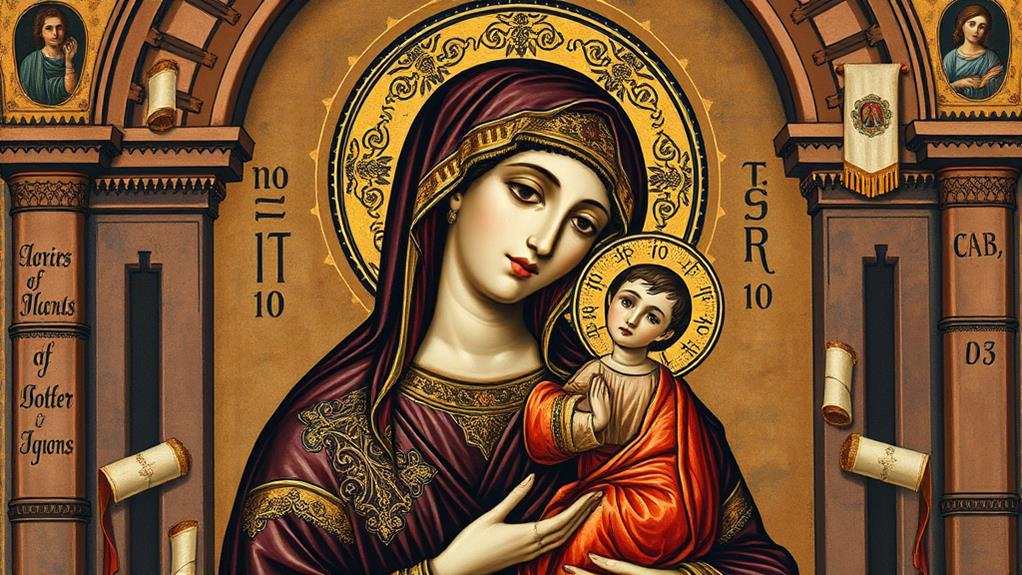
The historical significance of the Theotokos, or "God-bearer," lies deeply rooted in the development of Christian theology and Marian devotion.
From the early centuries of Christianity, the title "Theotokos" became essential in affirming Christ's dual nature as both divine and human. This theological formulation was solidified at the Council of Ephesus in 431 AD, where the Church officially declared Mary as the Mother of God, establishing her pivotal role in salvation history.
I find it fascinating how this designation not only elevated Mary's status but also fostered a profound respect for women within the Christian tradition.
The veneration of the Theotokos allowed believers to recognize her as a significant intercessor, bridging the gap between humanity and divinity. This reverence manifested in various artistic expressions and liturgical practices, further embedding the Theotokos in the Christian consciousness.
The historical narrative surrounding the Theotokos reflects broader themes of incarnation, redemption, and maternal love, which resonate deeply with believers.
In my exploration of this topic, I see the Theotokos as a symbol of faith, serving as a reminder of the divine's embodiment in human experience. Her significance continues to inspire devotion and theological reflection in contemporary Christianity.
Popular Design Styles
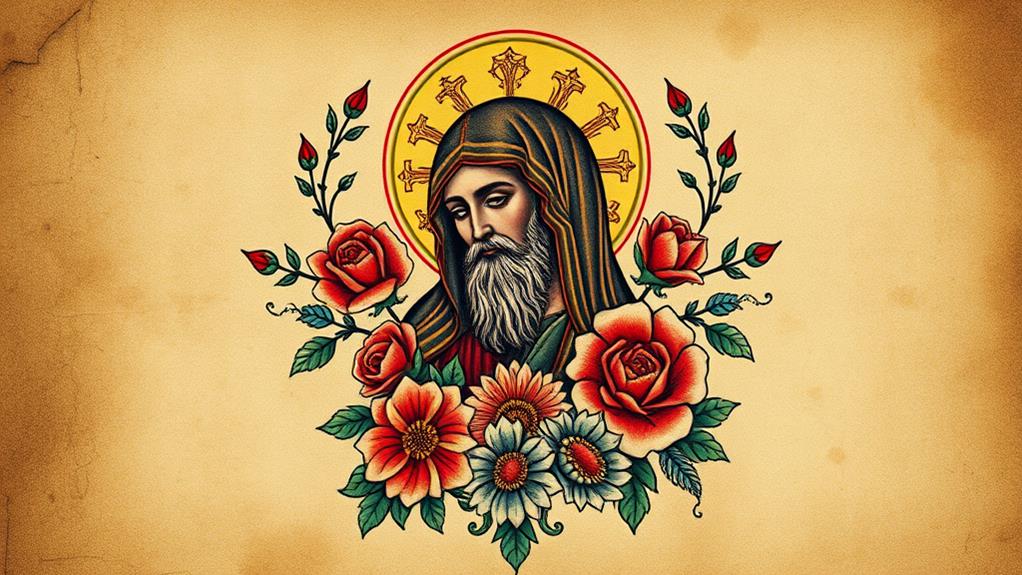
In exploring popular design styles for Theotokos tattoos, I find it fascinating how traditional iconography continues to influence contemporary expressions.
The intricate details and symbolism inherent in historical representations often clash with modern artistic interpretations that embrace abstraction and minimalism.
This tension between the sacred and the secular reveals much about cultural shifts and personal beliefs surrounding the imagery of the Theotokos.
Traditional Iconography Elements
Many people find themselves drawn to the rich tapestry of traditional iconography when choosing Theotokos tattoos, as these designs often encapsulate deep spiritual meanings and cultural significance.
When I explore these tattoos, I notice several common elements that define traditional iconography, such as the use of gold leaf, vibrant colors, and symbolic motifs.
These features serve not only an aesthetic purpose but also convey theological concepts, like the divinity of Mary.
For instance, the arrangement of the figures in these designs is meticulously planned.
The Theotokos is often depicted in a frontal pose, emphasizing her role as the Mother of God.
Surrounding elements, such as angels or saints, provide context and underscore her importance within the Christian faith.
The color palette is also significant; blue often symbolizes her purity while red signifies her divine nature.
Furthermore, the incorporation of intricate patterns and halos enhances the sense of sanctity.
Each line and curve in these tattoos is deliberate, aiming to evoke reverence.
These traditional iconographic elements not only celebrate the spiritual essence of the Theotokos but also connect the wearer to a broader cultural heritage, making them profoundly meaningful choices.
Modern Artistic Interpretations
While traditional iconography remains a significant source of inspiration, modern artistic interpretations of Theotokos tattoos embrace a diverse array of design styles that reflect contemporary aesthetics and personal expression.
I've noticed that many artists are now incorporating elements from abstract art, minimalism, and even surrealism into their depictions of the Mother of God. This shift allows for a more personal connection, as individuals can choose designs that resonate with their unique experiences and beliefs.
For instance, minimalist designs strip away ornate details, focusing instead on simple lines and shapes that convey deep meaning.
I find these tattoos particularly striking, as they invite contemplation and invite viewers to reflect on the essence of motherhood and divinity.
Conversely, some artists blend traditional motifs with modern graphic styles, creating vibrant, eye-catching pieces that celebrate both heritage and innovation.
Watercolor tattoos, with their fluid, ethereal quality, also stand out, offering a fresh perspective on the sacred image.
Symbolism and Meaning
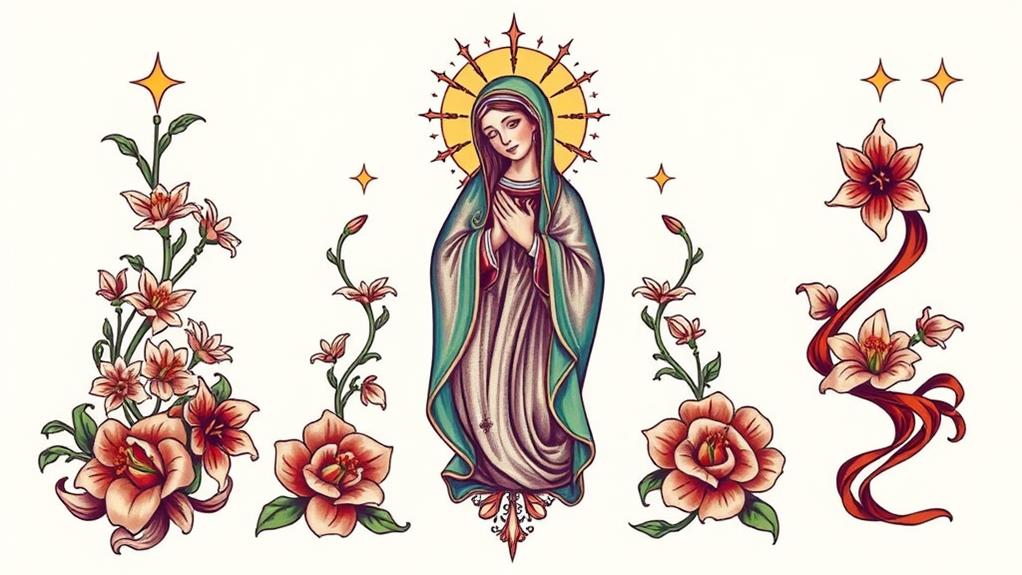
In exploring Theotokos tattoos, I find that they often embody powerful themes of maternal love and spiritual protection.
These symbols resonate deeply within various cultural contexts, representing not only a connection to divine motherhood but also a source of comfort and guidance.
Understanding these meanings enriches our appreciation of the tattoos and their significance in individual narratives.
Maternal Love Symbolism
Through the lens of iconography, Theotokos tattoos embody profound maternal love, reflecting the deep emotional bonds between mothers and their children.
The imagery often portrays Mary holding the Christ child, a powerful representation of nurturing and protection. This visual narrative resonates with anyone who experiences the unconditional love inherent in motherhood.
In the context of Theotokos, maternal love transcends mere affection; it symbolizes sacrifice, devotion, and an unwavering commitment to one's offspring.
The tenderness in Mary's expression signifies a deep emotional connection, illustrating a love that's both protective and empowering. When adorned as a tattoo, this imagery serves as a personal reminder of these values, often resonating with the wearer's own experiences of motherhood or their relationship with maternal figures.
Culturally, Theotokos tattoos also carry the weight of history and tradition, linking the wearer to centuries of devotion and veneration of Mary.
Each design choice—be it colors, style, or accompanying elements—further personalizes the depiction of maternal love, making it a unique expression of the wearer's journey and beliefs.
Ultimately, these tattoos encapsulate an enduring legacy of love and compassion, making them deeply meaningful.
Spiritual Protection Significance
Many people view Theotokos tattoos as symbols of spiritual safeguard, drawing on the deep-seated conviction in Mary's intercessory power.
This conviction stems from the understanding of Mary as the Mother of God, a figure who not only nurtures but also shields believers from spiritual harm.
When I delve into the symbolism inherent in these tattoos, I recognize how they embody a connection to divine favor and solace.
The act of wearing a Theotokos tattoo transforms it into a personal charm, representing a protective bulwark against negativity and adversity.
For many, it serves as a constant reminder of faith and the belief in divine assistance.
The imagery often reflects traditional Byzantine art, where Mary is depicted with open arms, inviting the faithful into her embrace, symbolizing refuge and support.
Moreover, these tattoos can be seen as a manifestation of one's spiritual odyssey, marking significant moments where one felt Mary's presence or guidance.
In this sense, the tattoo becomes more than just body art; it signifies a profound bond with the divine, reinforcing the notion that spiritual safeguard isn't merely a concept but a lived experience.
Placement Options for Tattoos
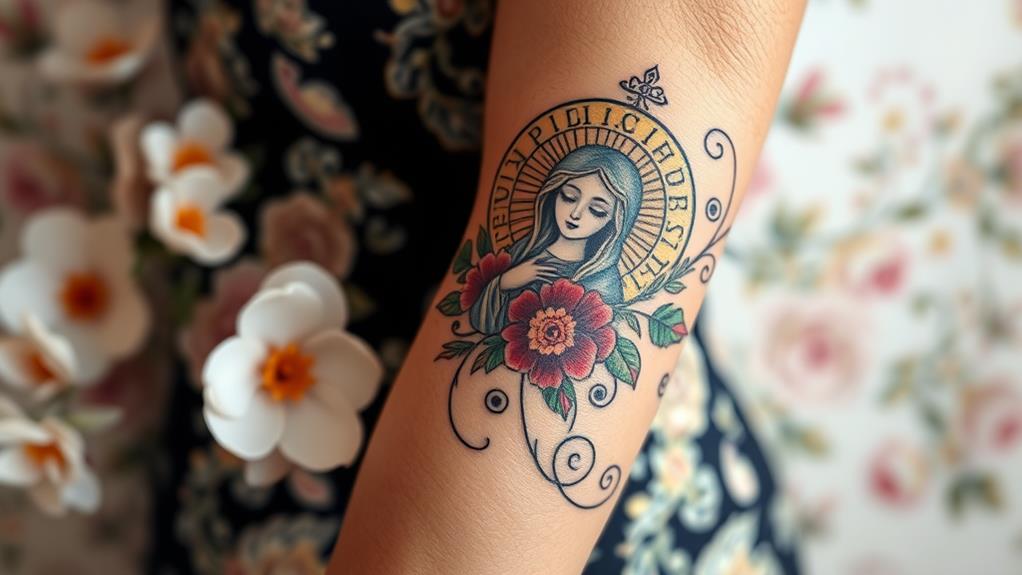
When considering placement options for Theotokos tattoos, several factors come into play that can profoundly influence both aesthetics and personal significance.
I've found that the location of the tattoo can communicate different meanings and impact how I perceive it over time. For instance, placing a tattoo on my forearm allows for visibility, sparking conversations about faith and artistry.
On the other hand, a tattoo on my back or chest might feel more intimate, serving as a personal reminder of devotion that only I see.
The nature of Theotokos tattoos, often rich in detail and symbolism, can make them particularly effective when showcased on larger areas of the body, such as the upper arm or thigh.
Furthermore, I've considered how societal norms and personal comfort influence my choices. A visible tattoo can invite scrutiny, while a concealed one can provide a sense of privacy.
Ultimately, selecting the right placement involves balancing the desire for expression with considerations of personal comfort and societal perceptions. Each choice reflects not just aesthetic preferences but also deeper connections to meaning and identity surrounding the sacred representation of the Mother of God.
Caring for Your Tattoo
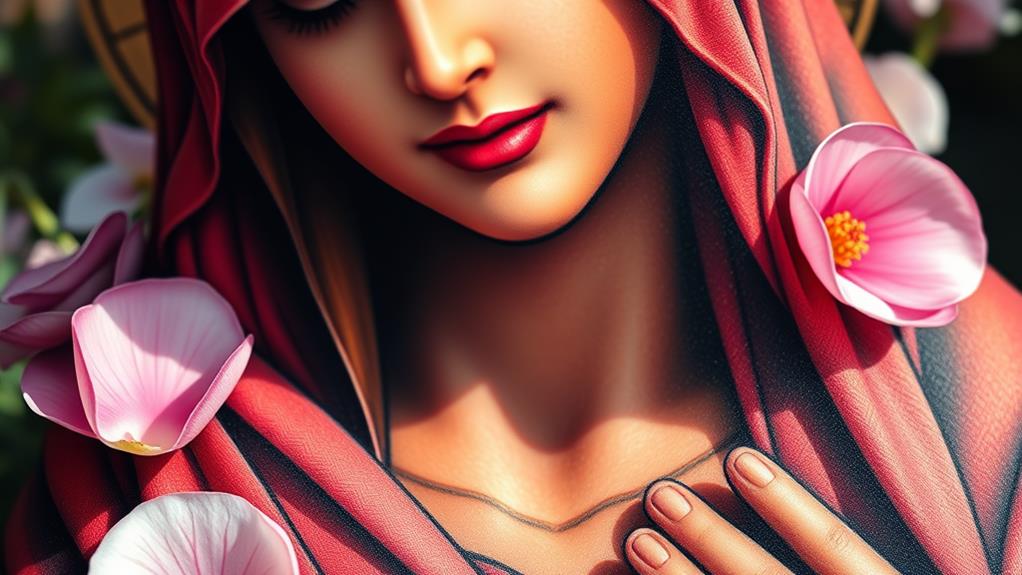
Caring for a tattoo, particularly one as meaningful as a Theotokos design, requires a thoughtful approach to certify its longevity and vibrancy.
After the initial healing period, which typically lasts about two weeks, I've learned that ongoing care remains essential. I always keep the tattoo moisturized using a fragrance-free lotion, as dry skin can lead to fading and cracking.
Sun exposure is another critical factor; UV rays can notably diminish the colors over time. I make it a point to apply a high-SPF sunscreen whenever I'm outdoors, protecting the intricate details of my tattoo from premature aging.
Additionally, I avoid soaking my tattoo in water, especially in pools or hot tubs, since prolonged exposure can disrupt the healing process and fade the design.
Regular touch-ups are also worth considering. As I've discovered, even the best tattoos might need occasional revitalization to maintain their original beauty.
Finding the Right Artist
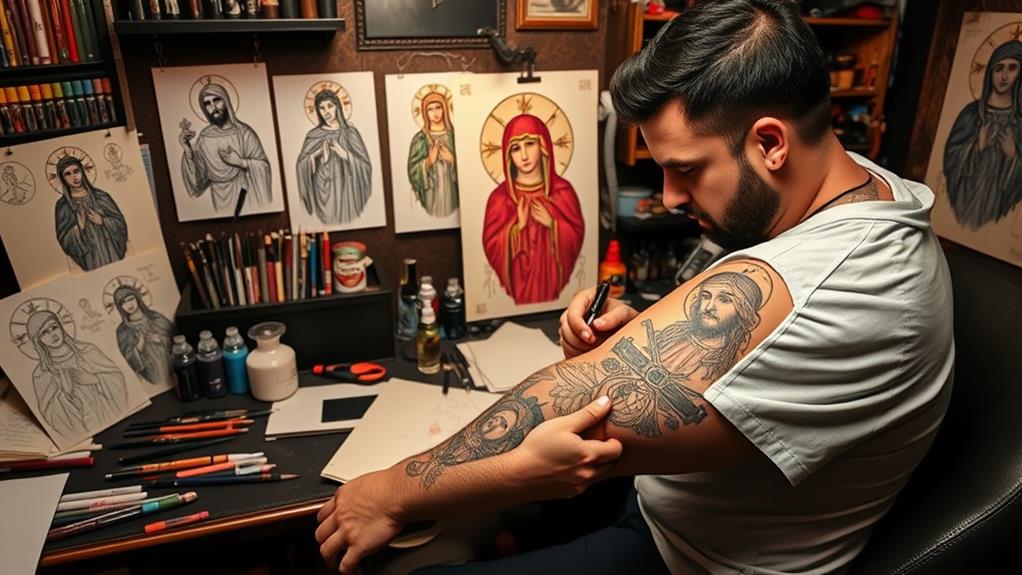
Finding the right artist for a Theotokos tattoo is crucial to achieving a design that resonates with both personal significance and artistic integrity.
I've learned that not all tattooists are created equal, especially when it comes to intricate religious imagery.
It's important to weigh several factors when selecting an artist who can honor the essence of the Mother of God in their work.
Portfolio Quality: I always review an artist's portfolio for their experience with religious themes and detailed designs. This helps me gauge their skill level and style.
Cultural Sensitivity: Since Theotokos tattoos carry deep spiritual meaning, I guarantee the artist understands the cultural context and significance of the imagery.
Client Testimonials: I seek out reviews and feedback from previous clients to assess their satisfaction with both the artistry and the overall experience.
Ultimately, I believe finding the right artist is an investment in a piece of art that reflects not just beauty, but also my faith and connection to the divine.
It's a decision that deserves thorough deliberation.
Frequently Asked Questions
Are There Any Specific Colors Associated With Theotokos Tattoos?
When exploring colors associated with Theotokos tattoos, I've noticed that deep blues, reds, and golds often dominate. These hues symbolize purity, divinity, and love, reflecting the rich tradition and spiritual significance behind these designs.
Can Theotokos Tattoos Be Combined With Other Religious Symbols?
I believe combining Theotokos tattoos with other religious symbols can create a rich tapestry of faith expression. It enhances personal meaning, allowing a deeper connection to one's beliefs while respecting the significance of each symbol involved.
What Are Common Misconceptions About Theotokos Tattoos?
I've noticed many misconceptions about Theotokos tattoos, particularly that they're purely decorative or only for certain religions. In reality, they hold deep spiritual significance and embody a rich tapestry of faith and cultural heritage.
Are Theotokos Tattoos Appropriate for Non-Religious Individuals?
I believe the appropriateness of tattoos depends on individual beliefs and respect for symbolism. Non-religious individuals might appreciate the artistry, but we must weigh the cultural and spiritual significance behind such designs.
How Do Cultural Interpretations of Theotokos Tattoos Vary?
Cultural interpretations of tattoos vary widely, reflecting individual beliefs and societal norms. I've noticed that while some view Theotokos tattoos as sacred, others see them merely as artistic expressions, highlighting the diversity in personal significance.
